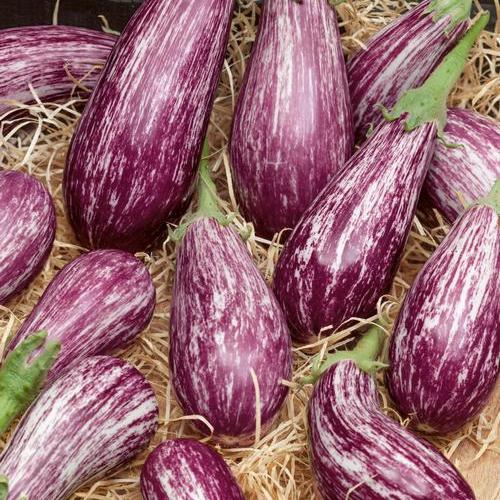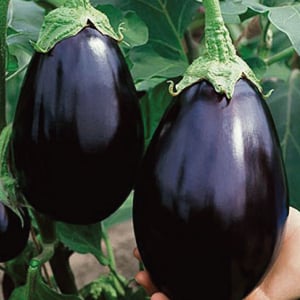
Learning Download: How to Grow Eggplant
From Seed to Harvest: A guide to growing eggplants.
Eggplant is a nutritious fruit used in italian Asian and Indian dishes, and it also serves as a substitute for meat in dishes like eggplant lasagna and eggplant parmesan. In addition to the common slender, long, deep purple eggplant, there are many varieties including colors of white, orange, light purple and various shapes. Eggplant has a texture similar to squash.
To plant:
Start eggplant seeds indoors up to 10 weeks before the last frost date. Plant the seeds 1/4inch deep, water after planting and cover loosely with plastic to retain moisture. Transplant the seedlings to the garden when soil temperatures reach 60 degrees. Leave up to 24 inches between plants in rows set 2 to 3 feet apart.
To grow:
Eggplants do best in rich, well-drained soil. Mulch can help eggplants boost their growth in the spring, and adding a light-colored straw-like mulch in the summer helps reduce heat build-up. Eggplants prefer a soil pH of 6.5 and 1 to 2 inches of water per week.
To harvest
Eggplants are ready to harvest as soon as 70 days after sowing the seeds. Harvest fruits with skin that is glossy and thin. Eggplants can be harvested when they are small, though growing them longer allows for a larger harvest. Harvestable fruits should be firm and inside seeds should not be visible once cut open. The inside flesh of the eggplant should be cream colored.
To harvest, beware of the eggplant’s prickly stem. The fruit bruises easily, so be gentle while harvesting. Use prunes or a sharp knife to cut the fruit from the plant, but be sure to keep a short piece of stem on the fruit. Harvesting eggplant frequently encourages more growth.
What eggplant craves:
Though eggplant is a relatively simple plant to grow, they are heavy feeders. The addition of fertilizer can better the plant. Prior to planting outdoors, mix 2 to 3 inches of well-rotted manure into the soil. If manure is not available, opt for a 10-10-10 fertilizer instead. Mix the manure or fertilizer at least 6 inches into the soil to provide fertilization to the eggplants roots as they grow. Once fruits begin to appear on the plant, spread a 10-20-20 fertilizer or 10-30-10 fertilizer up to 8 inches around the plant.
Where to buy eggplant seeds:
You can find many different shapes and colors of eggplant seeds at Urban Farmer.
Learning Download: Common pests and diseases: Eggplants
Common pests and diseases: Eggplants
When growing vegetables, it is always exciting to care for the plant throughout its growing phase and then harvest it for delicious recipes later on, but one thing to watch out for is pests and diseases. Different plants are susceptible to different types of pests and diseases, and it is important to make yourself aware so you can keep a watchful eye and also take any preventative methods to keep your plants safe throughout their lifespan.
Eggplants can fall victim to several different pests and diseases.
Pests:
Common pests affecting eggplants are lace bugs and flea beetles. Others include tomato hornworms, mites, aphids and cutworms.
For gardeners trying to prevent bugs commonly affecting eggplants, the best way is to utilize floating row covers until the plants are old enough to withstand insect attacks. Once the plants are old enough, use an insecticidal soap to treat any bugs causing issues. Be sure to keep all weeds and debris to a minimum so insects don’t overwinter, and utilize crop rotation. Introduce beneficial insects, such as lady bugs, into the garden because they will be predators to some of the insects causing harm to your plants.
Diseases:
In addition to various pests, diseases can also cause harm to your eggplant plants. Common diseases affecting eggplants include blossom end rot, bacterial wilt, verticium wilt, southern blight, Phomopsis blight and phytophthora blight.
Blossom end rot, which also commonly affects tomatoes, is caused by a fungus due to the gardener overwatering. This disease affects ripe fruits and causes leather-like sunken spots to appear on the fruit ends and cause the fruit to drop.
 Bacterial wilt causes plants to droop suddenly, from the bottom up, and turn yellow.
Bacterial wilt causes plants to droop suddenly, from the bottom up, and turn yellow.
Southern blight is caused by a fungus and plants will show a crown softening and mold also may appear on the plant and in the soil nearby.
Phomopsis blight affects the fruit, which will form sunken spots that get bigger and become soft or spongy.
Phytophthora blight, also commonly affecting peppers, can kill an eggplant quickly. Plants will have dark streaks, and they will collapse and die. This disease is common in wetter areas, with a soil temperature of between 75 and 85 degrees. There’s no way to cure this disease so be sure prevention is utilized. Increasing drainage can help prevent the problem, and this can be done by planting eggplants in a raised bed. Be sure not to overwater.
There are several ways to prevent the above diseases from destroying your crops. Eliminate the problem by practicing good crop rotation, keep weeds out of the garden and leaving plenty of space between plants for good air circulation and correct watering.

